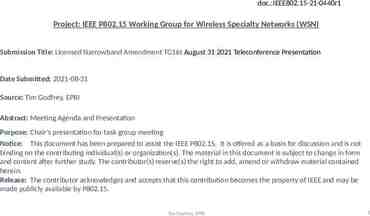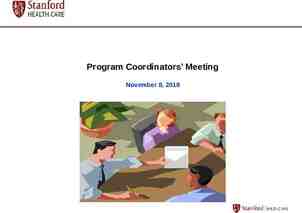Foster Care Redesign: Improving Child/Youth Placement Outcomes
22 Slides148.50 KB
Foster Care Redesign: Improving Child/Youth Placement Outcomes Stakeholder Forum June 14, 2010 1
Challenges Facing the Texas Child Welfare System Imbalance in geographic distribution of services and providers Insufficient number of residential providers that offer a full continuum of services 2
Current Equation (Child’s Needs) (Lack of Community Resources) Placement outside of home community Increased number of changes in placement Separation from sibling(s) and family Lack of educational continuity Fractured social support system 3
Goal of Redesign "The goal of the (foster care) redesign is to improve outcomes for children and families by creating sustainable placement resources in communities that will meet the service needs of children and youth in foster care, using the least restrictive placement settings." 4
Redesigning the Equation (Child’s Needs) (Adequate Community Resources) Placement in home community Decreased number of changes in placement Placement with sibling(s) in close proximity to family Educational continuity Strong social support system 5
Project Objectives Determine where and what kind of services are needed Determine how to contract for quality services, including recommended outcomes, performance measures and procurement processes Determine how to pay for those services (fiscal system/payment methodologies that align incentives with process and quality objectives) 6
Project Parameters Case management will remain the role of DFPS, however, model can include expanding role of the private sector’s work with families System design will neither preclude nor require additional funding 7
Decision-Making Approach Analyze/consider data Identify and define problems Generate options and assess feasibility of options Develop models that ‘test’ hypotheses and their corresponding policy, programmatic, practice and fiscal manifestations Engage stakeholders in reviewing/refining the analysis Final recommendations and a plan for implementing new foster care system due by December 31, 2010 8
Technical and Planning Expertise DFPS has contracted with two entities who are working collaboratively to develop the redesign proposal: PDF Group, LLC: - Engaging stakeholders - Managing, planning and developing the proposal, including recommendations for a systemic, effective approach to remodeling the current foster care system Chapin Hall, University of Chicago: - Working with American Humane - Facilitating and coordinating fact-finding research - Obtaining stakeholder input and support - Analyzing data and conducting simulation modeling 9
It’s A Winning Scenario! Goal – Children spend less time in care. How – Provider establishes network of foster homes in counties where demand exceeds supply Result – Proximity equals support and minimal escalation of behavioral issues Impact – Reduced placement disruptions; children achieve permanency more quickly Fiscal – Lower levels of need; less time in care resulting in a reduction in revenue for provider (improved outcomes create disincentive for provider) Leverage – (Through redesign) Provider is able to reinvest a % of the revenue the state would have otherwise paid for child to remain in care at higher level of need. 10
Stakeholders Children and families Judiciary Providers Foster care network/association Child advocates DFPS field staff Others which include, but are not limited to: - HHSC, Medicaid, and other enterprise agencies - Texas child welfare boards - State and federal child welfare partners 11
Public Private Partnership (PPP) Representative of key stakeholder groups including: Foster youth alumni Providers Child advocates Judiciary DFPS Advisory Council DFPS executive leadership Role in the redesign effort: Provide guidance to the initiative Serve as conduit of communication between constituents and peers Propose recommendations to DFPS Commissioner 12
Communications Principles Fully engage stakeholders - Provide opportunities for meaningful input - Keep stakeholders fully informed of project status Ensure understanding of Foster Care Redesign project objectives Provide all information in an inclusive, transparent manner to ensure project integrity Provide opportunities for the Department to understand and stay current on stakeholder interests and opinions 13
Communications Methods Website - Project updates and notices - Project survey - Mailbox - Alerts In-person meetings E-mail Briefings Stakeholder forum 14
Communications Progress Stakeholders around the state have been engaged in project activities since January 11, 2010 Project website, mailbox and survey were launched in April 2010 - 622 public and private stakeholders responded - 95 Texas counties represented in survey responses Over 600 public and private stakeholders have been involved in face-to-face meetings - Regional provider meetings - Focus groups - Stakeholder initiated presentations and meetings More planned stakeholder forums coming 15
External Stakeholder Input Systemic (Primarily Provider Issues) Eliminate Billing Service Level More Predictability Regarding Number and Type of Placements Want Better “Up-Front” Assessments Want to Work With Families of Children They are Caring For 16
Internal Stakeholder Input Concerns – Will Something Really Happen? – How Will Implementation Impact My Workload? – Fiscal and Political Implications Ideas – Eliminate Billing Service Level – Eliminate “Leveling” Based on Behavior 17
Stakeholder Consensus Quality Indicators Continuum of Services Services to Child; Not Child to Services De-Link Authorized and Billing Service Levels 18
Child Outcomes Improved child functioning as indicated by a decrease in intensity of service need while in care More timely achievement of permanency - Reunification - Adoption - Permanent and legal placement with relatives 19
Quality Indicators Children are placed in their home communities Children are appropriately served in the least restrictive environment that supports minimal moves for the child Connections to family and others important to the child are maintained Children are placed with siblings Services respect the child’s culture 20
Stakeholder Question Given the agency’s current budget constraints, what costneutral suggestions do you have to improve outcomes that support children being: - Placed in their home communities? - Appropriately served in the least restrictive environment that supports minimal moves? - Connected to family and other individuals important to them? - Placed with siblings? - Offered services that respect their culture? 21
Questions or Additional Comments? Email: [email protected] Information will also be posted to our website at www.dfps.state.tx.us/Child Protection/Foster Care/redesign.asp 22



























